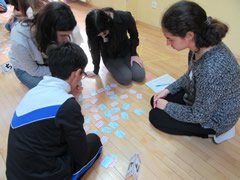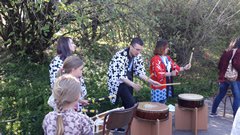Making Connections Through Japanese and Japanese Culture
University of Bucharest
KURIHARA Sachiko
Eight months have already passed since I took up my post in Romania in September 2016. I was dispatched to the University of Bucharest, which is at the heart of Japanese studies and Japanese-language education within Romania: from undergraduate to postgraduate level, just under 200 students study here. On a day-to-day basis, the students learn about Japanese studies subjects, including Japanese literature and Japanese culture, and about subjects related to the Japanese language, such as kanji, grammar, and conversation; Japanese-Language Specialists (hereinafter “Specialists”) and Japanese-Language Assistants work with colleagues to take responsibility for Japanese-language education. I believe that, in addition to normal classes, one of our roles as Specialists is to support the students in making connections with lots of different people through their studies of Japanese, which is a foreign language for these learners. This time, I’ll introduce two examples of how the students studying Japanese studies at the University of Bucharest, where I have been dispatched, have made connections through Japanese language and Japan.
Connecting with Japanese People Living in Romania: “Exchanges with Bucharest Japanese School”
As Kuroda, who was a Specialist here, noted in last year’s report, the University of Bucharest is continuing its exchanges with Bucharest Japanese School. The second-year students visited the school again this year.
On the day, the students observed the classes held after the opening ceremony; they watched, in order, Japanese language, Society, Science, and mathematics classes, among others. After the visit, we asked the students about their impressions, and from these it seems that they sensed how different this was from the Romanian schools that they had experienced—in particular, in the way the teachers taught, and in the relationships between the students and the teachers.

Taking on the challenge of the Hyakunin Isshu card game
After the students had observed the classes, they engaged in an activity with the students of the Bucharest Japanese School. This time, when considering the details of the exchange program, the Japanese Studies staff intended to ensure that there was a link between the content of the exchanges and students’ learning at the University, and decided that the students should take on the challenge of the Hyakunin Isshu (100 poems by 100 poets) Karuta card game. We started making preparations by talking about what Hyakunin Isshu is before visiting the Bucharest Japanese School, then showed the students videos of competitive Karuta and explained how to play Karuta; they then practiced many times, and memorized as many verses as possible. They competed with the students of the Bucharest Japanese School, which was a great challenge for the Japanese Studies students—they seemed surprised at the children’s speed, but the people in the top positions were given prizes, and in the end this was an experience that led to the students having a heightened desire to do their best.
Making Connections with the People of Bucharest: “Michi-biraki”
The students of the University of Bucharest’s Japanese Studies Department have also made connections with the people of Bucharest through the Japanese language and culture that they study. Each year, the Japanese Studies Department holds a Japanese cultural festival called “Michi-biraki,” meaning “paving the way”; this year was the eighth festival. There are several different student club activities in the Japanese Studies Department that carry out extracurricular activities, ranging from clubs for traditional culture (such as calligraphy (Shodo) and flower arrangement (Ikebana)) and clubs connected to the Japanese language (such as theater, chorus, and Karuta) to clubs related to pop culture. Preparations for Michi-biraki focused on these student clubs. Michi-biraki is a student-led event, and so we, as teaching staff, offer logistical support for management and activities. I also participated in the activities as a member of the chorus club.

Introducing children to Taiko drumming
The day of the Michi-biraki was blessed with beautiful, clear spring weather, and at the botanical garden in the city of Bucharest, which was our venue, we welcomed the wife of the Japanese ambassador to Romania, and opened with choral, theater, and Soran Bushi performances (traditional songs and dance in Japan) under the direction of our MCs, one dressed in a yukata (traditional Japanese dress), and one in the national costume of Romania.
The program content was wide ranging, and included a popular experience area for children with Origami(paper craft), coloring books, and a picture-story show; pop culture such as a maid café and Anime; demonstrations of the tea ceremony, flower arranging, and Taiko drumming; workshops for calligraphy, indigo dyeing, Origami, Furoshiki (wrapping cloths), and Karuta, and Japanese-language classes. Dressing up Kimono and selling sushi were so incredibly popular that the participants formed lines, and I saw kimono-wearing participants taking photos in lots of different poses in the beautiful botanical gardens. Almost all of the programs at the festival can be experienced for free, and the takings from sales made from the maid café, sushi, and similar activities are donated to charity each year. This year, we donated to a group that supports disadvantaged children and a group that supports the homeless.
Recently, Kendama, a cup-and-ball game, has become hugely popular among Romanian children, and interest in Japanese culture and the Japanese language is spreading. It is thought that supporting Japanese-language education for young people in Romania will become a challenge in the future. I would like to continue to make efforts to support Japanese learners in Romania as they make many different types of connection.
- What We Do Top
- Arts and Cultural Exchange [Culture]
- Japanese-Language Education Overseas [Language]
- Japanese-Language Education Overseas [Language] Top
- Learn Japanese-language
- Teach Japanese-language
- Take Japanese-Language Test
- Know about Japanese-language education abroad
- The Japanese-Language Institute, Urawa
- The Japanese-Language Institute, Kansai
- Japanese-Language Programs for Foreign Specified Skilled Worker Candidates
- Japanese Language Education for Japanese Children Resident Overseas and for the Descendants of Migrants
- Archives
- Japanese Studies and Global Partnerships [Dialogue]
- JF digital collection
- Other Programs / Programs to Commemorate Exchange Year
- Awards and Prizes
- Publications
